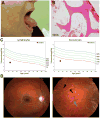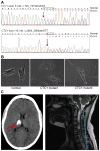CTC1 Mutations in a patient with dyskeratosis congenita
- PMID: 22532422
- PMCID: PMC3374040
- DOI: 10.1002/pbc.24193
CTC1 Mutations in a patient with dyskeratosis congenita
Abstract
Dyskeratosis congenita (DC) is a rare inherited bone marrow failure syndrome caused by mutations in seven genes involved in telomere biology, with approximately 50% of cases remaining genetically uncharacterized. We report a patient with classic DC carrying a compound heterozygous mutation in the CTC1 (conserved telomere maintenance component 1) gene, which has recently implicated in the pleiotropic syndrome Coats plus. This report confirms a molecular link between DC and Coats plus and expands the genotype-phenotype complexity observed in telomere-related genetic disorders.
Copyright © 2012 Wiley Periodicals, Inc.
Conflict of interest statement
The authors declare no conflicts of interest.
Figures


Comment in
-
An emerging role for the conserved telomere component 1 (CTC1) in human genetic disease.Pediatr Blood Cancer. 2012 Aug;59(2):209-10. doi: 10.1002/pbc.24200. Epub 2012 May 3. Pediatr Blood Cancer. 2012. PMID: 22556055 No abstract available.
References
Publication types
MeSH terms
Substances
Grants and funding
LinkOut - more resources
Full Text Sources
Medical

